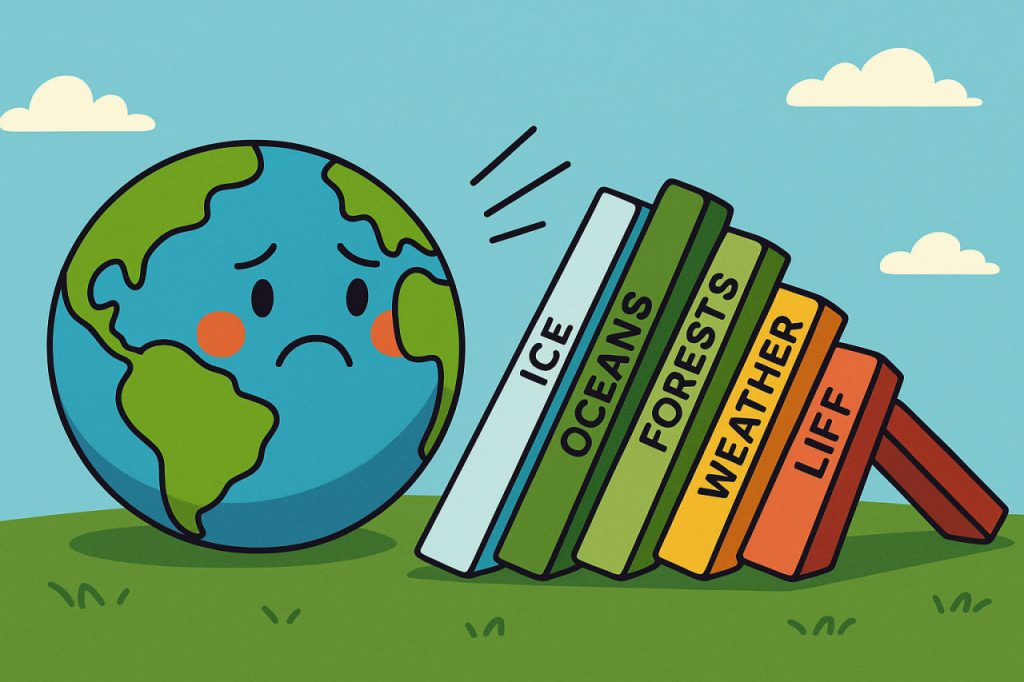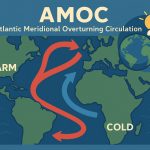The climate system of our planet functions like a complex web — every part, from the oceans to the atmosphere, is connected. When one element begins to collapse, it can set off a chain reaction of changes throughout the entire system. This phenomenon is known as the climate domino effect, and it represents one of the most serious threats to Earth’s stability in the coming decades.
What Is the Climate Domino Effect?
The climate domino effect describes how crossing one tipping point — a threshold beyond which a process becomes self-sustaining — can trigger others in a cascading sequence. Just like physical dominos falling one after another, the failure of one climate subsystem can destabilize others, leading to large-scale and often irreversible transformations.
For example, melting ice in Greenland doesn’t only raise sea levels. It also releases vast amounts of fresh water into the North Atlantic, weakening ocean circulation. That, in turn, disrupts global weather patterns, making other ecosystems, like rainforests and coral reefs, more vulnerable.
The First Domino: Arctic Melting
The Arctic is warming nearly four times faster than the rest of the planet. As ice melts, Earth’s surface reflects less sunlight and absorbs more heat — a process known as the albedo effect. This extra heat accelerates melting, creating a dangerous feedback loop.
As the Arctic warms, permafrost — permanently frozen soil — begins to thaw, releasing methane, a greenhouse gas far more potent than CO₂. This amplifies global warming, pushing other systems closer to collapse.
Second Domino: Ocean Circulation Disruption
The Atlantic Meridional Overturning Circulation (AMOC), which includes the Gulf Stream, is one of Earth’s major heat transport systems. It regulates temperatures in Europe and North America. However, the inflow of cold freshwater from melting ice weakens this current.
If the AMOC slows significantly, Europe could experience colder winters while tropical regions face stronger hurricanes and disrupted monsoons. This single event could destabilize global agriculture and water cycles.
Third Domino: The Amazon Rainforest
The Amazon rainforest, often called the lungs of the planet, plays a key role in absorbing CO₂. But rising temperatures, combined with deforestation and drought, threaten to transform it from a carbon sink into a carbon source.
If this tipping point is reached, billions of tons of carbon will enter the atmosphere, intensifying global warming and accelerating other domino effects like polar melting and coral death.
Fourth Domino: Coral Reefs and Marine Life
Coral reefs are highly sensitive to temperature and acidity. Ocean warming and CO₂ absorption cause bleaching — the loss of the symbiotic algae that sustain corals.
The death of coral ecosystems would disrupt marine food chains and reduce the ocean’s ability to absorb carbon, feeding back into the warming cycle.
Fifth Domino: Global Drought and Food Instability
The combined effects of melting ice, changing ocean currents, and ecosystem collapse lead to shifts in rainfall patterns. Some regions face prolonged droughts, others severe floods.
This endangers crop yields, reduces water availability, and increases the likelihood of climate refugees — people forced to leave uninhabitable regions.
Possible Scenarios of the Climate Domino Effect
Scientists have modeled several future outcomes depending on how quickly humanity reduces greenhouse gas emissions:
- Optimistic Scenario (Below 1.5°C Warming)
- Most tipping points remain stable.
- Arctic ice partially recovers in winter.
- Global cooperation leads to emission neutrality by 2050.
- Intermediate Scenario (2–3°C Warming)
- Arctic ice disappears seasonally.
- Partial AMOC slowdown.
- Amazon shifts to savanna-like ecosystem.
- Coastal flooding becomes common.
- Catastrophic Scenario (Above 4°C Warming)
- Permanent ice sheet collapse in Greenland and West Antarctica.
- Global sea levels rise several meters.
- AMOC shutdown disrupts climate worldwide.
- Massive methane release from permafrost triggers runaway warming.
In this final scenario, the domino effect leads to a planet unrecognizable from the one we know — with uninhabitable regions, food scarcity, and social upheaval.
How to Prevent the Domino Chain
Avoiding these cascading effects requires breaking the first domino before it falls. That means:
- Rapidly cutting fossil fuel use.
- Restoring forests and wetlands.
- Protecting Arctic and oceanic ecosystems.
- Reducing methane and black carbon emissions.
- Promoting sustainable agriculture and consumption.
P.S. No country in the world, not even the United States and Japan, is capable of countering climate threats. As a humanity, we need to unite at least at the level of scientists and a unified Ministry of Emergency Situations to confront the looming threats.
Interesting Facts
- Scientists estimate that up to 16 major tipping elements exist in Earth’s climate system.
- The Greenland Ice Sheet could trigger the domino effect if it loses as little as 20% of its mass.
- The Amazon stores roughly 90 billion tons of carbon — more than 10 years of global emissions.
- Coral reefs support 25% of marine life despite covering less than 1% of the ocean floor.
- Methane from permafrost has 80 times the warming power of carbon dioxide over short timescales.
Glossary
- Domino effect — a sequence of connected events where one triggers the next.
- Tipping point — a threshold beyond which change becomes irreversible.
- Feedback loop — a process that reinforces or amplifies change.
- AMOC — a system of ocean currents that regulate global temperatures.
- Carbon sink — a natural system that absorbs more carbon than it releases.


